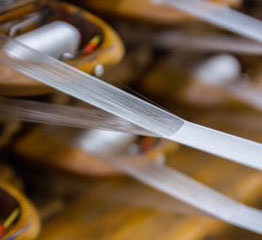Weaving is a textile production method that uses a loom to interlace two sets of yarn at right angles. To create fabric, the lateral yarn, called the weft, repeatedly crosses with the longitudinal yarn, referred to as the warp, which is held taught by the loom.
The process of weaving can be summarized in three steps:
- Shedding — The warp ends are separated to clear a space for a pick
- Picking — The pick inserts the weft through the shed
- Beating — The reed pushes the weft up against the fell of the cloth completing one weave cycle
Although the basic weaving process is the same, the specific method in which the yarn is interlaced and propelled through the shed can change the characteristics of the finished fabric. Popular methods of weaving include the use of:
- Shuttle loom
- Shuttleless loom
- Jacquard loom
Shuttle Loom
 This conventional loom type – which includes hand looms, non-automatic power looms, and automatic weaving machines – interlaces the weft and warp yarn using a shuttle (usually made of wood). This method can manufacture seamless fabrics and tubular materials, making it suitable for critical applications requiring uniformity. It is slower than shuttleless looms.
This conventional loom type – which includes hand looms, non-automatic power looms, and automatic weaving machines – interlaces the weft and warp yarn using a shuttle (usually made of wood). This method can manufacture seamless fabrics and tubular materials, making it suitable for critical applications requiring uniformity. It is slower than shuttleless looms.
Shuttleless Loom
This is a loom type which includes needle looms, rapier looms, and water/air jet looms. Its highly efficient operation increases production capacities while reducing large run labor costs. Needle loom models produce material with one woven edge and one knitted edge.
Jacquard Loom
A jacquard loom is a mechanical loom that simplifies the manufacture of complex patterns. Originally controlled by a sequence of hole-punched cards laced together, these looms now operate under CAD systems. They can be labor-intensive to set up initially. Jacquard weaving is a durable, high quality alternative to printed webbing, capable of producing a variety of weaves, designs, and logos from a single warp.
About Bally Ribbon Mills
Bally Ribbon Mills (BRM) is capable of each of these weaving methods, as well as specialty broadcloth, utilized for R&D and special projects with the ability to weave up to 72” widths. In addition to our diverse offering of weaving technologies, BRM provides a host of secondary processes such as dyeing, finishing, strap cutting, hole punching, and sonic welding.
For more information about weaving, download our free eBook, Shuttle Loom Weaving: Benefits for Critical Use.





